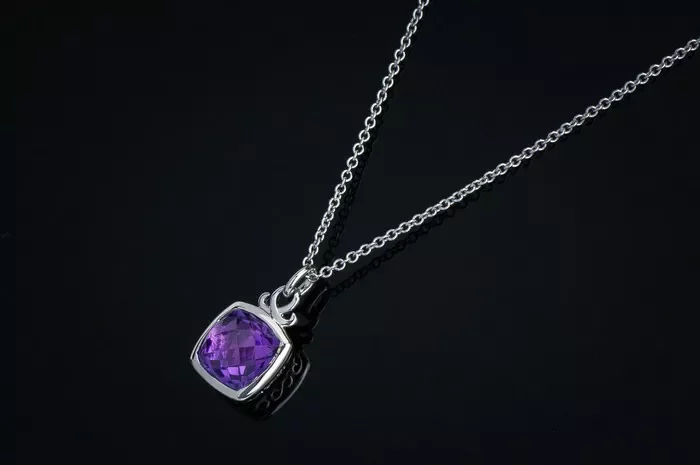Amethyst, a type of quartz crystal, is known for its rich purple hue and is a semi-precious stone cherished for its beauty and spiritual connotations. The value of an amethyst article is determined by a complex interplay of factors that can vary greatly, affecting its appeal and worth in the gemstone market. This article will explore these determinants in detail, from color and clarity to cut and carat weight, providing a comprehensive guide for understanding the factors that influence the value of amethyst jewelry.
Color: The Crowning Glory of Amethyst
The color of amethyst is its most captivating feature and the primary determinant of its value. The most sought-after amethysts display a deep, rich purple color, often described as “royal purple.” The hue should be as close to this shade as possible, with minimal brown or gray undertones that can dull the stone’s appeal. The color intensity and saturation are also crucial; a more vivid and intense purple will command a higher price. Additionally, the color should be consistent across the stone, with no zones of lighter or darker hue that can detract from its uniform beauty.
Carat Weight: The Heft of Value
The size of an amethyst, measured in carats, is another significant factor in its value. Larger amethysts are rarer and thus more valuable, but there is a point of diminishing returns. Stones that are extremely large, say over 25 carats, may not increase in value as one might expect because they are less common in jewelry and more often used in decorative objects or as collector’s items. However, a well-proportioned and well-cut amethyst of significant size will always be a valuable asset.
Clarity: The Window to the Stone’s Soul
Clarity refers to the absence of inclusions or blemishes within the amethyst. A clear, eye-clean amethyst is highly prized because it allows light to pass through the stone with minimal obstruction, enhancing its brilliance and fire. Inclusions can be tiny mineral deposits, fractures, or even gas bubbles trapped within the crystal during its formation. While completely flawless amethysts are rare, those with fewer inclusions are more valuable. The placement of any inclusions is also important; those that are visible to the naked eye and located in the center of the stone can significantly lower the value.
Origin: The Birthplace of the Gem
The origin of an amethyst can influence its value due to the different qualities associated with amethysts from various locations. For example, amethysts from Brazil are known for their deep color and high clarity, making them highly desirable. Similarly, amethysts from Uruguay are prized for their Lavender hues and the fact that they are often free of inclusions. In contrast, amethysts from other regions may be less expensive due to lower quality or less stringent standards of color and clarity.
Cut: The Art of Illuminating Beauty
The cut of an amethyst is as much an art as it is a science. A well-cut amethyst will maximize its brilliance, fire, and overall visual appeal. The cut refers to the proportions, symmetry, and polish of the stone. A stone that is cut too shallow or too deep will lose light through the sides or the bottom, reducing its sparkle. The most common cuts for amethysts are oval, round, and cushion, but fancy cuts can also add to the stone’s value, especially if they are well-executed and enhance the stone’s natural beauty.
Treatment: Enhancing Nature’s Creation
Many amethysts on the market today undergo some form of treatment to enhance their color or clarity. Heat treatment is the most common, as it can lighten or darken the color of amethyst, making it more uniform and desirable. Irradiation is another method used to create the rarer green amethyst. While treated stones are more affordable, untreated stones are generally more valuable due to their natural state. It’s essential to disclose whether an amethyst has been treated, as this can significantly affect its value.
Carving and Craftsmanship: The Hand of the Artisan
Carved amethysts, often used in decorative pieces or as beads, can also be evaluated based on the intricacy and quality of the carving. A well-carved amethyst with fine detail and smooth, even surfaces will be more valuable than a poorly carved one. Hand-carved amethysts, which show the individuality and skill of the artisan, are often more sought after than machine-carved pieces.
Market Trends and Demand
The value of amethyst jewelry is also influenced by market trends and consumer demand. Fashion, cultural significance, and even economic conditions can all play a role in determining how desirable amethyst jewelry is at any given time. For example, during periods when purple is a popular fashion color, demand for amethyst jewelry may increase, driving up prices.
Conclusion
In conclusion, the value of an amethyst article is a multifaceted equation that includes color, carat weight, clarity, origin, cut, treatment, and craftsmanship. Understanding these factors is crucial for anyone looking to buy, sell, or appraise amethyst jewelry. While some factors are more客观 than others, all contribute to the stone’s overall appeal and worth. As with any gemstone, the value of amethyst is ultimately determined by the balance of these elements and the unique characteristics that make each piece a one-of-a-kind treasure.
Related topic:
- What Is Amethyst Stalactite Flower
- The Difference Between Amethyst and Selenite
- The Difference Between Amethyst and Clear Quartz


